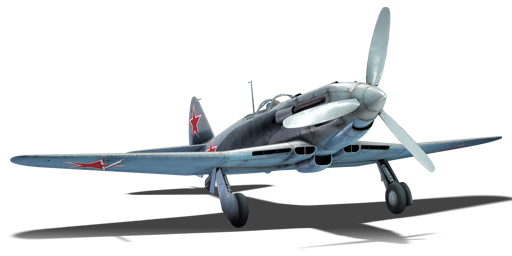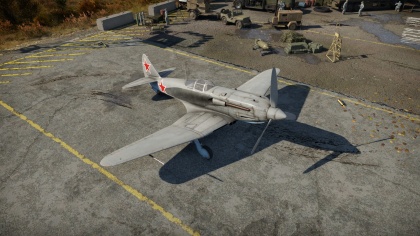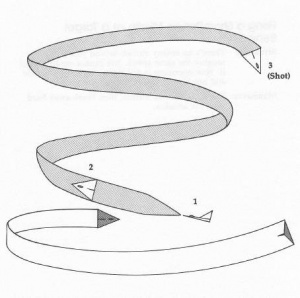I-225
Contents
Description
The I-225 is a rank IV Russian fighter
with a battle rating of 5.7 (AB), 5.0 (RB), and 6.0 (SB). It was introduced in Update 1.81 "The Valkyries". As of Update 1.89 "Imperial Navy", it is the last prop plane in the MiG/Polikarpov line, and is one of the best prop fighters Russia has to offer.
General info
Flight performance
The I-225 is the latest claim to the throne of Russian prop-fighters! With its high speed at high altitudes, decent armament, good turning capabilities and insane climb rate, this Super-MiG is the best all around dog-fighter Russia has to offer. Although relatively useless as an interceptor in real life, the I-225 is quite potent in War Thunder, being one of four Russian props that is good at altitude, which is very unique for the Russian tree that is mostly comprised of low-altitude prop planes. From take-off and into the fight, this MiG is an overall smooth operator and can be very competitive even when facing early jets.
| Characteristics | |||||||
|---|---|---|---|---|---|---|---|
| Stock | |||||||
| Max Speed (km/h at 10,000 m) |
Max altitude (meters) |
Turn time (seconds) |
Rate of climb (meters/second) |
Take-off run (meters) | |||
| AB | RB | AB | RB | AB | RB | ||
| 702 | 682 | 10450 | 19.9 | 20.4 | 16.7 | 16.6 | 257 |
| Upgraded | |||||||
| Max Speed (km/h at 10,000 m) |
Max altitude (meters) |
Turn time (seconds) |
Rate of climb (meters/second) |
Take-off run (meters) | |||
| AB | RB | AB | RB | AB | RB | ||
| ??? | 726 | 10450 | ??.? | 19.0 | ??.? | 20.8 | 257 |
Details
| Features | ||||
|---|---|---|---|---|
| Combat flaps | Take-off flaps | Landing flaps | Air brakes | Arrestor gear |
| X | ✓ | ✓ | X | X |
| Limits | ||||
|---|---|---|---|---|
| Wing-break speed (km/h) |
Gear limit (km/h) |
Combat flaps (km/h) |
Max Static G | |
| + | - | |||
| 400 | ~11 | ~5 | ||
| Optimal velocities | |||
|---|---|---|---|
| Ailerons (km/h) |
Rudder (km/h) |
Elevators (km/h) |
Radiator (km/h) |
| < 350 | < 250 | < 460 | > 370 |
| Compressor (RB/SB) | ||
|---|---|---|
| Setting 1 | ||
| Optimal altitude | 100% Engine power | WEP Engine power |
| 8,800 m | 1,500 hp | 1,610 hp |
Survivability and armour
Armour plates:
- 9 mm steel behind the pilot
Critical components
- Fuel tank in the fuselage behind the pilot
- Fuel tank in front of the guns and behind the engine
- Liquid cooling systems in front of the spars near the slats
- Oil Cooling systems underneath the nose
Armaments
Offensive armament
The I-225 is armed with:
- 4 x 20 mm ShVAK cannons, nose-mounted (100 rpg = 400 total)
The 20 mm ShVAK cannons are very accurate and are extremely powerful in controlled, well aimed bursts to enemy wings and critical components. However they are notorious for their hit registration issues (sparking) earning them the nickname of "The SparkVAK's". These hit detection issues combined with the high fire rate and lacklustre raw damage make them very volatile weapons that are not beginner friendly, but the solid accuracy and high rate of fire can also be a boon to a smart and experienced pilot who can abuse these factors.
Usage in battles
The I-225 can be used to climb to bomber altitude (4-6 km) and act as an interceptor, and it can perform this role amicably with its good climb rate, high speed and fast firing quad ShVAK 20 mm cannons that can start fires. Be wary that the I-225 has no bulletproof glass in the front to protect this pilot, so you should never tail any bomber and approach from oblique angles or force head-ons. Also its armament of four 20 mm can be lacking against large aircraft, so I-225 players will likely have to expend all of their ammo in a bomber if they want to bring it down.
If one either destroys all the bombers or there are no bombers to be found, you are free to fly as a fighter versus other fighters. When engaging fighters, primarily try to employ a Boom-&-Zoom or energy fighting tactics which are exceptionally great when performed at high altitudes. Versus less manoeuvrable planes such as the F8F-1B, you can potentially turn-fight but be careful to not lose too much energy, as you may struggle to regain it. Also avoid tunnel visioning, as the I-225's weakness is anything extended due to an increased chance that multiple enemies will engage you.
Offensive flying:
When offensively engaging an enemy, the pilot should use the amazing performance and superb dive speed to their advantage, as the I-225 is the most vulnerable when it is unable to use these traits. Your go-to flying style should be energy fighting or Boom-&-Zoom, as both of these rely on top speed, energy retention, diving speed, climb rate, and these areas are where the I-225 excels the most. Always make sure to be above your enemy so you maintain an energy advantage.
Your ideal altitude is 6 km, as this is where you can make the most out of the powerful turbocharged AM-42 engine and abuse your insane dive speed to its potential.
Defensive flying:
If an enemy manages to get on your tail or has you in their gunsights, you should enter a slight dive in order to make use of your amazing dive speed and excellent acceleration. Being an energy fighter, you can make use of energy wasting maneuvers such as spiral climbing, displacement rolls, Immelmann turns or vertical spirals. Vertical spirals are particularly effective thanks to your excellent energy retention.
Specific enemies worth noting
- Spitfire F Mk 22 and Mk 24. The extremely powerful Griffon engined Spitfires are some of the most dangerous enemies you will encounter at this BR. They possess an amazing climb rate, amazing roll rate, brutal acceleration, high speed, solid manoeuvrability and excellent high altitude performance. Their quad Hispano Mk II's can load a very potent Air targets belt which is filled with HEF-I and HEF-SAPI rounds that will shred your airframe to bits with a quick burst. Try to keep a higher altitude than it and dive on it if it's unaware of your presence. When one is engaging you, try to bleed its energy with vertical manoeuvres or if you're confident enough, you can turn fight it.
- Bf 109 K-4. The last of the legendary Bf 109's can also be encountered. You can outspeed it by a large margin and have superior acceleration and dive speed. Avoid employing an energy fighting play style as the K-4 has amazing energy retention and a solid climb rate, although the I-225 can take advantage of its strange refusal to stall when using WEP in order to beat the 109 in the vertical, although it is not recommended to use it in this way. Always remain on its tail and steer clear of its gunsights, as its powerful array of armaments (1 x 30 mm cannon or 3 x 20 mm cannons, both of which are loaded with the brutal Minengeschoß round) will down you quickly if they land a few good hits. Employ a Boom-&-Zoom play style to take advantage of your superior speed and high diving speed.
- F8F-1B. The feared Bearcat is one of the best prop planes in the game, and is the worst enemy for the I-225 to face, as the Bearcat outclasses it in practically every way aside from performance above 6 km. The Bearcat out-turns you, out-rolls you, out-climbs you, and has an extremely devastating set of AN/M2 cannons which are effectively Hispano Mk V's. Avoid them at all costs unless they are unaware of your presence, and if one forces an engagement on you, seek assistance from teammates.
- Ta 152 H-1. While not a major enemy, it is possible to encounter the Ta 152 at higher altitudes where its engine performs the best. The outcome of the fight comes down to the more skilled pilot, as the two planes are fairly even performance wise. Never let a Ta 152 get you in its gunsights, as it sports an incredibly powerful array of armaments that can shred through you like paper. You have a superior turning rate and energy retention but the 152 beats you in a dive, so focus on vertical maneuvers.
Manual Engine Control
| MEC elements | ||||||
|---|---|---|---|---|---|---|
| Mixer | Pitch | Radiator | Supercharger | Turbocharger | ||
| Oil | Water | Type | ||||
| Controllable | Controllable Not auto controlled |
Controllable Not auto controlled |
Controllable Auto control available |
Separate | Not controllable 1 gear |
Not controllable |
Modules
| Tier | Flight performance | Survivability | Weaponry | |
|---|---|---|---|---|
| I | Fuselage repair | Radiator | Offensive 20 mm | |
| II | Compressor | Airframe | ||
| III | Wings repair | Engine | New 20 mm cannons | |
| IV | Engine injection | Cover | ||
The default belts of the ShVAK's are quite efficient and the cannons themselves are very accurate, so you should focus on performance upgrades. The most important upgrades are the engine, engine injection and then the survivability modules to help remedy the weak airframe of the I-225.
Pros and cons
Pros:
- Responsive controls from very low up to moderately high speeds (up to ~550 km/h)
- Excellent vertical energy retention which the pilot can use to their advantage
- The plane refuses to stall if using higher throttle settings (such as WEP), and remains very responsive up to the moment that it enters a stall
- Inclusion of a turbocharger mounted in place of the regular exhaust stacks allows for good performance at high altitudes
- Four fast firing nose mounted cannons that are capable of tearing apart any plane with a well aimed sustained burst with more than 50 shells hitting the target in a 1 second burst.
- Good to insanely great level flight speed at high altitudes (able to reach 750 km/h at 9,500 meters altitude!)
- Solid manoeuvrability at most speeds that piston aircraft fly at
- Above average roll rate
- Offers a different play style compared to most Russian planes
- Very good climb rate
- Brutal acceleration in a dive (and in about every single situation other than in extremely high speeds)
- Insane energy retention when turning without flaps
- Flaps help it to turn/"position itself" a slightly better if used correctly
- Take-off flaps only rip at 360 km/h
- Amazing cockpit view, despite a few bars
- Very powerful engine with 1,600 horsepower with WEP and over 2,000 horsepower in arcade
Cons:
- Cannons have low ammo count, only 100 rounds per gun, which will last very little because of their high rate of fire
- ShVAK cannons have a reputation for sparking and simply not dealing enough damage to down a plane
- No bulletproof glass means the pilot is easily knocked out
- Severe nonsensical elevator compression past ~650 km/h (IAS), and becomes a brick past 700 km/h
- Can face early jets, which pose a huge challenge especially because of their high speeds
- Has no combat flaps, only take-off and landing settings
- While flaps help a little with turning, they do not help with pitching the nose up in any noticeable way and will make the aircraft bleed speed and energy
- Air-frame is very susceptible to damage
- Fires have a very high chance of downing the plane
- Massive fuel consumption when using WEP. Not recommended to use minimal fuel, stick to 20 minutes whenever possible.
History
The experimental high-altitude fighter/interceptor I-225 was created in the Mikoyan design bureau as part of work to develop new prototypes of fighter aircraft with new engines. The first experimental prototype was finished by May 9, 1944. The aircraft was designed to carry a powertrain consisting of a 2000 horsepower aircraft engine and a turbocharger. Its armament in comparison with previous prototypes was strengthened and consisted of four 20mm ShVAK cannons. In testing (primarily tests of the fighter's speed and altitude options) the aircraft showed impressive results: it could reach a speed of almost 560 km/h near the ground and 720 km/h at high altitude. Just two I-225s were built for testing purposes. For various reasons, both aircraft crashed in testing. After a range of improvements and upgrades, in March 1947 work on this project was stopped.
- From Devblog
Media
Excellent additions to the article would be video guides, screenshots from the game, and photos.
See also
Links to the articles on the War Thunder Wiki that you think will be useful for the reader, for example:
- reference to the series of the aircraft;
- links to approximate analogues of other nations and research trees.
External links
| USSR fighters | |
|---|---|
| I-15 | I-15 WR · I-15 M-22 · I-15 M-25 · I-15bis · Krasnolutsky's I-15bis |
| I-153 M-62 · Zhukovsky's I-153-M62 · I-153P | |
| I-16 | I-16 type 5 · I-16 type 10 · I-16 type 18 · I-16 type 24 · I-16 type 27 · I-16 type 28 · I-180S |
| I-29 | I-29 |
| I-185 | I-185 (M-71) · I-185 (M-82) |
| I-225 | I-225 |
| ITP | ITP (M-1) |
| MiG-3 | MiG-3-15 · MiG-3-15 (BK) · MiG-3-34 |
| LaGG | I-301 · LaGG-3-4 · LaGG-3-8 · LaGG-3-11 · LaGG-3-23 · LaGG-3-34 · LaGG-3-35 · LaGG-3-66 |
| La | La-5 · La-5F · La-5FN · La-7 · Dolgushin's La-7 · La-7B-20 · La-9 · La-11 |
| Yak-1/7 | Yak-1 · Yak-1B · Yak-7B |
| Yak-3 | Yak-3 · Eremin's Yak-3(e) · Yak-3P · Yak-3T · Yak-3U · Yak-3 (VK-107) |
| Yak-9 | Yak-9 · Yak-9B · Golovachev's Yak-9M · Yak-9T · Yak-9K · Yak-9U · Yak-9UT · Yak-9P |
| Other countries | ▂P-40E-1 · ▂P-47D-27 · ▂Hurricane Mk IIB · ▂Fw 190 D-9 · ▂Spitfire Mk IXc |
| P-39 | ▂P-39K-1 · ▂Pokryshkin's P-39N-0 · ▂P-39Q-15 |
| P-63 | ▂P-63A-5 · ▂P-63A-10 · ▂P-63C-5 |






